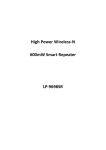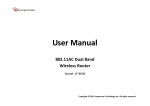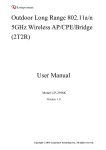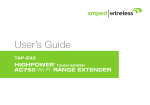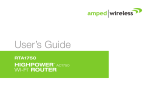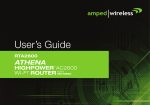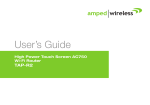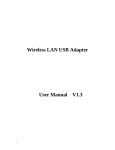Download User`s Guide - SysNet Center
Transcript
User’s Guide High Power Wireless-N 600mW Gigabit Dual Band Repeater LP‐9778SR User Manual CONTENTS GETTING STARTED .......................................................................... 1 Package Contents................................................................................. 1 LED Indicators ...................................................................................... 2 Back Panel Description......................................................................... 3 SETUP GUIDE .................................................................................. 4 Welcome to the Smart Setup Wizard .................................................. 7 Scan for a Wireless Network................................................................ 8 Connecting to a Secure Network ......................................................... 9 Extended Network Settings (SSID and Security)................................ 10 Setup Summary ................................................................................. 12 5.0GHz WI‐FI SETTINGS..................................................................15 Network Settings (5.0GHz)................................................................. 15 Extended Network Settings (5.0GHz) ................................................ 16 Security (5.0GHz) ............................................................................... 18 Wi‐Fi Protected Setup – WPS (5.0GHz).............................................. 19 User Access (5.0GHz) ......................................................................... 20 Wireless Coverage Controls (5.0GHz) ................................................ 21 Access Schedule (5.0GHz) .................................................................. 22 Advanced Settings (5.0GHz)............................................................... 23 2.4GHz WI‐FI SETTINGS..................................................................24 Home Network Settings (2.4GHz) ...................................................... 24 Extended Network Settings (2.4GHz) ................................................ 25 Security (2.4GHz)................................................................................ 27 Wi‐Fi Protected Setup – WPS (2.4GHz)..............................................28 User Access (2.4GHz) .........................................................................29 Wireless Coverage Controls (2.4GHz) ................................................30 Access Schedule (2.4GHz) ..................................................................31 Advanced Settings (2.4GHz)...............................................................32 USB STORAGE................................................................................33 Local Sharing ......................................................................................33 NETWORK SETTINGS......................................................................37 IP Settings........................................................................................... 37 Wired Port Routing ............................................................................39 MANAGEMENT FEATURES .............................................................40 Repeater Status..................................................................................41 Network Statistics ..............................................................................43 System Clock ......................................................................................44 System Logs........................................................................................45 Upgrade Firmware .............................................................................46 Save/Reload Settings.......................................................................... 47 Password Settings ..............................................................................48 TECHNICAL SPECIFICATIONS ..........................................................49 DEFAULT SETTINGS........................................................................50 TROUBLESHOOTING AND SUPPORT INFORMATION.......................51 1 LP‐9778SR User Manual GETTING STARTED Package Contents Check to make sure you have all the contents within your package: • High Power Wireless-N 600mW Gigabit Dual Band Repeater • Two Detachable 5dBi High Gain Antennas • Power Adapter (100-240v) • RJ-45 Ethernet Cable • Setup Guide • CD: User’s Guide, Installation Video • Stand for Vertical Mounting 1 LP‐9778SR User Manual LED Indicators Power: Indicates when the Dual Band Repeater is powered on. The LED will remain on. 5.0GHz Wireless Activity: Blinks rapidly when wireless data traffic is transmitted or received over the 5.0GHz wireless network. 2.4GHz Wireless Activity: Blinks rapidly when wireless data traffic is transmitted or received over the2.4GHz wireless network. Gigabit Wired Ports 1-5: Indicates when a networking device is connected to a wired port on the back of the Dual Band Repeater. The LED blinks rapidly when wired data traffic is transmitted or received. USB Connection: Indicates when a USB storage device is connected to the USB port for local sharing. WPS: Wi-Fi Protected Setup activity. When the WPS mode is activated the WPS LED blinks as it awaits a connection. 2 LP‐9778SR User Manual Back Panel Description Antenna Connectors (1-2): RJ-SMA antenna connectors. Attach the included high gain dual band antennas to these connectors USB Port: Attach USB storage devices, such as USB flash drives and external hard drives, for file sharing. Reset: Push down once to reboot the Dual Band Repeater. Hold down for 5-10 seconds to reset the Dual Band Repeater back to factory settings. WPS: Hold down for 3 seconds to enable WPS push button configuration. Wired Devices: Gigabit RJ-45 ports for connecting to wired computers or network devices. Power: Power adapter port. Output: 12V 1A, Input: 100-240v 3 LP‐9778SR User Manual SETUP GUIDE Find a Setup Location The location of where you install the Dual Band Repeater is very important to how it will function. The optimal setup location should be somewhere no more than halfway between your wireless router and your wireless dead zone. 4 LP‐9778SR User Manual Connect your PC to the Dual Band Repeater a) Attach the antennas of the High Power Repeater to the antenna ports labeled 1 and 2 b) Connect the included grey network cable to an available port on your computer c) Attach the power adapter to the Dual Band Repeater’s PWR port and a power outlet Do NOT attempt to connect to the Dual Band Repeater with a wireless connection at this time. 5 LP‐9778SR User Manual Open your Web Browser to Access the Setup Wizard a. Open your web browser. b. Type in: http://setup.loopcomm.com into the web address bar. c. If the web menu fails to open, type in the following IP address into your web address bar: http://192.168.1.250 a. Disconnect your Pc from all wireless networks, open your browser and try again. b. If you continue to have problems accessing the Web Menu, disconnect the cable from your computer to the Repeater. Connect wirelessly ( SSID: Loopcomm_Rep2.4GHz or Loopcomm_Rep_5.0Ghz and Password: wireless) and try again. 6 LP‐9778SR User Manual Welcome to the Smart Setup Wizard When the web menu appears, click Next to proceed with the Smart Setup Wizard. The diagram on this page displays: 1) Home/Office Network: The existing network you are trying to repeat. 2) 2.4GHz/5.0GHz Extended Network: The extended network (amplified and rebroadcasted network). The terms above are used throughout the installation process to describe your Home Network and the Extended Network. 7 LP‐9778SR User Manual Scan for a Wireless Network Click SCAN to begin searching for available wireless networks to repeat. The Scan result will list all available 2.4GHz and 5.0GHz wireless networks detected by the Dual Band Repeater – including each network name (SSID), the operating channel, the type of security and the signal strength. If you are extending a dual band router, you will need to select the SSID of your 2.4GHz network and the SSID of your 5.0GHz network. The signal strength indicates the wireless connection between that network and the Dual Band Repeater. It is important to choose networks that are greater than 70%. A wireless network with a signal strength of less than 70% may create a poor connection which results in slower throughput and frequent dropped connections. If you fail to find any wireless networks, or your signal strength is below 70%, try moving the Dual Band Repeater closer to the wireless network that you are trying to repeat and click SCAN again. Once you have selected your wireless network(s), click Next to continue. If you are only connecting to one network, simply select that 2.4 or 5.0GHz network and click Next to continue. 8 LP‐9778SR User Manual Connecting to a Secure Network If the wireless network(s) you are trying to repeat has wireless security enabled, you will be prompted to enter a security key. If you are repeating a dual band router, you will need to enter the security key for both the 2.4GHz and 5.0GHz network. If either network does not have security, leave the field blank. After you have entered the security key(s), click Next to continue. If you do not know the key to the network you are trying to repeat, then click Back and select another network. 9 LP‐9778SR User Manual Extended Network Settings (SSID and Security) The default SSID of the Dual Band Repeater is “Loopcomm_Rep_2.4GHz” or “Loopcomm_Rep_5.0GHz” To change it, enter a new name in the SSID field. Users connecting wirelessly to the Dual Band Repeater will use this ID to identify your Extended Network.Configure the settings for your Extended Networks here. Depending on the capabilities of your wireless adapter, you may connect to either the 2.4 or 5.0GHz Extended Networks. 10 LP‐9778SR User Manual The default Security Key (WPA/WPA2 Mixed Mode) of your Extended Network(s) is: loopcommwifi. To change it, enter a new key in the Security Key field. The key must be a minimum of 8 characters. No security key is necessary for computers connecting to the Dual Band Repeater using a wired connection to the LAN ports. Click Next to complete the setup process. The Dual Band Repeater will reboot and apply your settings. Be patient and do not make any changes or adjustments to the Dual Band Repeater at this time. 11 LP‐9778SR User Manual Setup Summary Once the Dual Band Repeater has rebooted, it will load the Setup Summary page and provide you with the details of your setup. Congratulations, the Dual Band Repeater is now successfully configured. Your settings are now saved. Print the Setup Summary details and save it for future reference. At this time, you may disconnect from the Dual Band Repeater and start a wireless connection. If you have any wired devices that you would like to attach to the Dual Band Repeater, you may do so now. If you haven’t already positioned your Dual Band Repeater in an optimal location, you may do so. All Repeater settings are saved and can be safely powered off for relocation. Enjoy your Extended network! 12 LP‐9778SR User Manual Wired Port Routing The Smart Setup wizard automatically selects the Home Network (2.4GHz or 5.0GHz) your wired devices will be routed through to connect to the Internet. If you wish to change this setting you may do so from the web menu by accessing Network Settings >Wired Port Routing 13 LP‐9778SR User Manual If the Home/Office Network connection fails try the following… The failed connection page will provide you with information on why the connection failed. Read theinstructions carefully and retry your connection. The tips below will help to solve common issues: a. Check to make sure your Home Network security settings are correct. b. On the SCAN page, check that your Home Network is showing a signal of 70% or greater. If not, movethe Dual Band Repeater closer to your Home Network router and try again. If you are connecting to a dual band router, ensure that both the 2.4GHz and 5.0GHz networks show a signal strength of 70% or greater. c. Check that your Home Network router’s DHCP server is enabled. d. Try changing the channel of the Home Network router to a higher channel number (5-11) and run the Setup Wizard again. e. Check the internet connection on your Home Network wireless router. Connect directly to your router and attempt to access the web. If this fails, the problem is with your internet connection. Contact your broadband provider to fix this issue first before configuring the repeater. f. Try to reboot (unplug the power from the Dual Band Repeater and plug it back in) the Dual Band Repeater and check to see if the connection is established (some networks may be very slow and take longer than the allotted time for the Dual Band Repeater to successfully connect). 14 LP‐9778SR User Manual 5.0GHz WI-FI SETTINGS 5.0GHz Wi-Fi Settings: Home Network Settings (5.0GHz) The Home Network Settings (5.0GHz) page allows you to adjust settings for your 5.0GHz Home Network connection. These settings are for adjusting the Dual Band Repeater’s Home Network connection after you have already gone through the Smart Setup Wizard and wish to adjust your current configurations . Home Network SSID (5.0GHz): Manually enter the Identification name of the existing 5.0GHz Home Network you wish to connect to. Channel Number: Enter the channel number of the Home Network. If the channel number does not match, a connection will not be established. Channel Width: Wi-Fi operates in two separate channel widths, 20Hz and 40Hz. 40Hz allows for faster speeds. Each Channel Width will have a different selection of wireless channels to choose from. Select the channel width you wish to use for your network. This setting must match that of your Home Network for a successful connection. 15 LP‐9778SR User Manual 5.0GHz Wi-Fi Settings: Extended Network Settings (5.0GHz) The Extended Network Settings page allows you to adjust settings for your Extended Network. SSID of Extended Network: The name used to identify your Extended Network. This is the name that appears when a user scans for available Wi-Fi networks. Band: Allows you to setup access under a specific combination of Wi-Fi speed standards. Broadcast SSID: Selecting Disable Broadcast SSID will hide the visibility of the repeater’s SSID. Users must manually enter the SSID to connect. 16 LP‐9778SR User Manual Guest Networks (5.0GHz) Click “Enable” to create a Guest Network. Guest Networks provide a separate wireless network, with unique settings for users to connect to. Band: Restrict the Wi-Fi protocol and speed used for the specific Guest Network. SSID: This is the name of your Guest Network. Data Rate: Restrict access to the Guest Network by setting a lower bandwidth by changing the data rate. Broadcast SSID: Disable to hide your SSID from public view. Users will need to manually enter the SSID into their wireless software interface to connect. Access: Restrict access for Guest networks to allow Internet only connections and protect your local network. Associated Clients: View all computers and network devices that are connected to your Guest Network wirelessly. To set security settings for the Guest Network go to: 5.0GHz Wi-Fi Settings > Security. 17 LP‐9778SR User Manual 5.0GHz Wi-Fi Settings: Security (5.0GHz) Wireless security allows you to change the type of wireless security settings for your 5.0GHz Extended Network, Home Network or Guest Networks. Note: If you adjust the security of your Home Network and it is incorrect, the Dual Band Repeater will no longer have a successful connection to your Home Network. Using the drop down menu, you can select which network you wish to configure and may adjust the security settings below. If you are using the Guest Network feature, you will be able to adjust the security settings for those additional network SSIDs here as well. For more information on the differences between the types of Wi-Fi security available, please visit the Learning Center on the Amped Wireless website: http://www.loopcomm.com 18 LP‐9778SR User Manual 5 .0GHz Wi-Fi Settings: Wi-Fi Protected Setup – WPS (5.0GHz) WPS is a Wi-Fi feature created to make Wi-Fi setup simple and easy. Some wireless routers and adapters support this feature with varying names (i.e. one touch setup or WPS). You may enable WPS setup here by selecting the type of WPS setup you wish to use. The Dual Band Repeater supports all types of WPS setup: Option A: Push button: You may push the WPS button on the web menu or use the physical button on the back of the Dual Band Repeater. Option B: PIN: Some wireless devices use a PIN number to access wireless network. If your wireless device requests for a PIN number, then use the PIN code located here. Option C: Enter PIN: Some wireless devices require that you use a PIN number to add them to the wireless network. If your wireless device has a PIN number, then locate the number and enter in the field, then press Start Pin. 19 LP‐9778SR User Manual 5.0GHz Wi-Fi Settings: User Access (5.0GHz) User Access allows you to deny access or allow access to specific users connecting to the network. Each networking device has a unique address called a MAC address (a 12 digit hex number). By inputting the MAC address into the field, you can define whether that device is allowed into your network or not allowed. A MAC Address may sometimes be referred to as a Physical Address. Most networking devices have their MAC Address located on a label on the actual device. For Windows computers with internal networking adapters, the MAC Address can be found by viewing the Network Connection Details of the network adapter. The MAC Address will be listed as the Physical Address. Be sure to enter the MAC Address without any symbols. For example, a MAC Address of 78-DD-78-AA-78-BB would be entered as 78DD78AA78BB. 20 LP‐9778SR User Manual 5 .0GHz Wi-Fi Settings: Wireless Coverage Controls (5.0GHz) Adjust the output power of the Dual Band Repeater to control the coverage distance of your 5.0GHz Extended Wireless Network. For a smaller coverage area you can select a lower output power. For the maximum wireless coverage select the 100% selection. Note that if you select a lower output power, your connection to your 5.0GHz Home Network will also decrease in range. It is recommended that you test your signal strength after each adjustment. 21 LP‐9778SR User Manual 5.0GHz Wi-Fi Settings: Access Schedule (5.0GHz) Access Schedules will enable or disable your 5.0GHz wireless access at a set time based on your predefined schedule. This feature is often used for restricting access to all users (such as children, employees, guests) during specific times of the day for parental control or security reasons. a. Enable Access Schedule. b. Select which days you wish for your Wi-Fi to be available. c. Select the time frame during that day that you wish for Wi-Fi to be available. d. Apply Changes. Enabling Access Schedule will also disable internet access for wired connections on specified days. Note: Make sure you have already configured your System Clock in order for your schedule to work correctly. Time Zone Settings can be adjusted from the web menu under Management > Time Zone Settings. 22 LP‐9778SR User Manual 5.0GHz Wi-Fi Settings: Advanced Settings (5.0GHz) Advanced Wireless Settings should only be adjusted by technically advanced users. It is not recommended that novice users adjust these settings to avoid degrading wireless performance. Here are a few definitions on some settings. Fragment Threshold: The Default and Recommended setting is at 2346, meaning the High Power Repeater will never fragment any frames that it sends to wireless users. RTS Threshold: Adjusts the size of RTS data packets. Lower values reduce throughput, but allow the system to recover quicker from interference/collisions. Higher values provide the fastest throughput. Beacon Interval: Indicates the frequency interval of the beacon. A beacon is a packet broadcast by the repeater to sync the wireless network. Preamble Type: Defines the length of the Cyclic Redundancy Check for communication between the repeater and roaming wireless users. IAPP: Inter-Access Point Protocol STBC: Space Time Block Coding improves reception by coding the data stream in blocks. 23 LP‐9778SR User Manual 2.4GHz WI-FI SETTINGS 2.4GHz Wi-Fi Settings: Home Network Settings (2.4GHz) The Home Network Settings (2.4GHz) page allows you to adjust settings for your 2.4GHz Home Network connection. These settings are for adjusting the Dual Band Repeater’s Home Network connection after you have already gone through the Smart Setup Wizard and wish to adjust your current configurations. Home Network SSID (2.4GHz): Manually enter the Identification name of the existing 2.4GHz Home Network you wish to connect to. Channel Number: Enter the channel number of the Home Network. If the channel number does not match, a connection will not be established. Channel Width: Wi-Fi operates in two separate channel widths, 20Hz and 40Hz. 20Hz allows operation on channels 1-11, while 40Hz is 5-11. 40Hz allows for faster speeds. Select the channel width you wish to use for your network. This setting must match that of your Home Network for a successful connection. 24 LP‐9778SR User Manual 2 .4GHz Wi-Fi Settings: Extended Network Settings (2.4GHz) The Extended Network Settings page allows you to adjust settings for your Extended Network. SSID of Extended Network: The name used to identify your Extended Network. This is the name that appears when a user scans for available Wi-Fi networks. Band: Allows you to setup access under a specific combination of Wi-Fi speed standards. Broadcast SSID: Selecting Disable Broadcast SSID will hide the visibility of the repeater’s SSID. Users must manually enter the SSID to connect. 25 LP‐9778SR User Manual Guest Networks (2.4GHz) Click “Enable” to create a Guest Network. Guest Networks provide a separate wireless network, with unique settings for users to connect to. Band: Restrict the Wi-Fi protocol and speed used for the specific Guest Network. SSID: This is the name of your Guest Network. Data Rate: Restrict access to the Guest Network by setting a lower bandwidth by changing the data rate. Broadcast SSID: Disable to hide your SSID from public view. Users will need to manually enter the SSID into their wireless software interface to connect. Access: Restrict access for Guest networks to allow Internet only connections and protect your local network. Associated Clients: View all computers and network devices that are connected to your Guest Network wirelessly. To set security settings for the Guest Network go to: 2.4GHz Wi-Fi Settings > Security. 26 LP‐9778SR User Manual 2.4GHz Wi-Fi Settings: Security (2.4GHz) Wireless security allows you to change the type of wireless security settings for your 2.4GHz Extended Network, Home Network or Guest Networks. Note: If you adjust the security of your Home Network and it is incorrect, the Dual Band Repeater will no longer have a successful connection to your Home Network. Using the drop down menu, you can select which network you wish to configure and may adjust the security settings below. If you are using the Guest Network feature, you will be able to adjust the security settings for those additional network SSIDs here as well. 27 LP‐9778SR User Manual 2 .4GHz Wi-Fi Settings: Wi-Fi Protected Setup – WPS (2.4GHz) WPS is a Wi-Fi feature created to make Wi-Fi setup simple and easy. Some wireless routers and adapters support this feature with varying names (i.e. one touch setup or WPS). You may enable WPS setup here by selecting the type of WPS setup you wish to use. The Dual Band Repeater supports all types of WPS setup: Option A: Push button: You may push the WPS button on the web menu or use the physical button on the back of the Dual Band Repeater. Option B: PIN: Some wireless devices use a PIN number to access wireless network. If your wireless device requests for a PIN number, then use the PIN code located here. Option C: Enter PIN: Some wireless devices require that you use a PIN number to add them to the wireless network. If your wireless device has a PIN number, then locate the number and enter in the field, then press Start Pin. 28 LP‐9778SR User Manual 2.4GHz Wi-Fi Settings: User Access (2.4GHz) User Access allows you to deny access or allow access to specific users connecting to the network. Each networking device has a unique address called a MAC address (a 12 digit hex number). By inputting the MAC address into the field, you can define whether that device is allowed into your network or not allowed. A MAC Address may sometimes be referred to as a Physical Address. Most networking devices have their MAC Address located on a label on the actual device. For Windows computers with internal networking adapters, the MAC Address can be found by viewing the Network Connection Details of the network adapter. The MAC Address will be listed as the Physical Address. Be sure to enter the MAC Address without any symbols. For example, a MAC Address of 78-DD-78-AA-78-BB would be entered as 78DD78AA78BB. 29 LP‐9778SR User Manual 2 .4GHz Wi-Fi Settings: Wireless Coverage Controls (2.4GHz) Adjust the output power of the Dual Band Repeater to control the coverage distance of your 2.4GHz Extended Wireless Network. For a smaller coverage area you can select a lower output power. For the maximum wireless coverage select the 100% selection. Note that if you select a lower output power, your connection to your 2.4GHz Home Network will also decrease in range. It is recommended that you test your signal strength after each adjustment. 30 LP‐9778SR User Manual 2.4GHz Wi-Fi Settings: Access Schedule (2.4GHz) Access Schedules will enable or disable your 2.4GHz wireless access at a set time based on your predefined schedule. This feature is often used for restricting access to all users (such as children, employees, guests) during specific times of the day for parental control or security reasons. a. Enable Access Schedule. b. Select which days you wish for your Wi-Fi to be available. c. Select the time frame during that day that you wish for Wi-Fi to be available. d. Apply Changes. Enabling Access Schedule will also disable internet access for wired connections on specified days. Note: Make sure you have already configured your System Clock in order for your schedule to work correctly. Time Zone Settings can be adjusted from the web menu under Management > Time Zone Settings. 31 LP‐9778SR User Manual 2.4GHz Wi-Fi Settings: Advanced Settings (2.4GHz) Advanced Wireless Settings should only be adjusted by technically advanced users. It is not recommended that novice users adjust these settings to avoid degrading wireless performance. Here are a few definitions on some settings. Fragment Threshold: The Default and Recommended setting is at 2346, meaning the High Power Repeater will never fragment any frames that it sends to wireless users. RTS Threshold: Adjusts the size of RTS data packets. Lower values reduce throughput, but allow the system to recover quicker from interference/collisions. Higher values provide the fastest throughput. Beacon Interval: Indicates the frequency interval of the beacon. A beacon is a packet broadcast by the repeater to sync the wireless network. Preamble Type: Defines the length of the Cyclic Redundancy Check for communication between the repeater and roaming wireless users. IAPP: Inter-Access Point Protocol STBC: Space Time Block Coding improves reception by coding the data stream in blocks. 32 LP‐9778SR User Manual USB STORAGE USB Storage: Local Sharing Share a USB storage device with computers on the local network of the High Power Dual Band Repeater. Insert a USB storage device, such as a flash drive or external hard drive, to the USB port on the back of the Dual Band Repeater and follow the directions below for your operating system. The computer must be connected to your Home Network or Extended Network to access the storage device. You may also want to Map the Network Drive so it shows up as a standard drive on your computer for easier access. 33 LP‐9778SR User Manual Windows 7 and Vista To access the drive from your Windows desktop: Note: If the USB drive does not appear automatically under your Networked devices (Windows 7, Vista or Mac OS X), you will need to Map the Network Drive. a. Click the Start button b. Click Computer c. On the Computer page, the drive should appear on the left hand column under Network as Loopcomm_REP_USB To Map the Network Drive: a. Click the Start button b. Click Computer c. Click Map Network Drive from the top bar. d. Select a drive letter (any), then enter in the folder field: \\ repeater’s LAN IP address \public\ e. If the drive fails to open, click browse and locate Loopcomm_REP_USB under Network. 34 LP‐9778SR User Manual Windows XP To access the drive from your Windows desktop: Note: If the USB drive does not appear automatically under your Networked devices (Windows 7, Vista or Mac OS X), you will need to Map the Network Drive. a. Click the Start button b. Click My Computer c. Click on My Network Places and locate the drive named Loopcomm_REP_USB To Map the network drive: a. Click the Start button b. Right Click My Computer and select Map Network Drive c. Select a drive letter (any), then enter in the folder field: \\repeater’s LAN IP address\public\ d. If the drive fails to open, click browse and locate Loopcomm_REP_USB under Network. 35 LP‐9778SR User Manual Mac OS X To access the drive from your Mac desktop: Note: If the USB drive does not appear automatically under your Networked devices, you will need to Map your Network Drive (Instructions below). a. Open Finder b. On the left hand menu, under Shared, click Loopcomm_REP_USB To Map the network drive: a. Open Finder b. From the menu on the top of the desktop, select Go c. Select Connect To Server from the drop down menu d. Enter the address of the network drive: smb://repeater’s LAN ip address/public Then click Connect If the network drive does not appear on your Mac desktop, follow these steps: a. Open Finder b. Select Preferences from the drop down menu c. Check show "Connected Servers" d. The drive should now appear on your desktop 36 LP‐9778SR User Manual NETWORK SETTINGS Network Settings: IP Settings IP Address: The IP address of the Dual Band Repeater. Subnet Mask: The subnet of the Dual Band Repeater. Default Gateway: The access point to another network, normally the Dual Band Repeater or your router. DHCP: The Dual Band Repeater includes a feature to help manage the IP addresses within your Extended network and with your Home Network automatically. When connected to a Home Network, the Repeater will obtain an IP address from your Home Network’s router and act as a DHCP Client. However, when there is no connection available, the Repeater will act as a DHCP Server. You may also manually control the IP settings of the Dual Band Repeater by choosing Client, Server or Disabled from the DHCP drop down menu. This is only for advanced users. 37 LP‐9778SR User Manual DHCP Client Range: The range of IP addresses the Dual Band Repeater’s DHCP server will assign to users and devices connecting to the Dual Band Repeater. Static DHCP: You may set a static IP address within your DHCP network. The Dual Band Repeater will track the device via its MAC address and assign it a pre-defined IP address each time the device logs into the network. Obtain IP settings from the Home router or manually enter your IP settings. Auto-Load Menu (Auto-DNS): When the Dual Band Repeater loses connection to your Home Network it will automatically redirect your web browser to the web menu. To turn this feature off, you can disable Auto-DNS. Note: Disabling Auto-DNS will require that you access the web menu using the IP address of this device. It is recommended that you note your IP address before changing this mode. If you are no longer able to access the web menu, you will need to perform a hardware reset. Domain Name: The Domain Name allows you to change the URL which is used to access the Setup Menu for the Dual Band Repeater. For example, entering http://192.168.1.254 into your web browser while connected to the Dual Band Repeater, will guide you to the Web menu for the Dual Band Repeater. By changing the Domain Name, you will change the URL entered to access the Web menu. If you forget the Domain Name you entered and can no longer access the Web menu, then you will need to reset your Dual Band Repeater to default settings by holding down the reset button on the back panel for 5-10 seconds. 38 LP‐9778SR User Manual Network Settings: Wired Port Routing If the Dual Band Repeater is connected to a dual band router, the Dual Band Repeater will automatically route the traffic from all devices connected to the Repeater’s wired ports through the 5.0GHz Home Network to access the web with the fastest speeds. If you choose, you may adjust this setting so that all wired traffic is routed through the 2.4GHz Home Network connection instead. If the Dual Band Repeater is only connected to a single Home Network, it will automatically route all wired traffic through the Home Network connection that is active. 39 LP‐9778SR User Manual MANAGEMENT FEATURES The Management features on the Dual Band Repeater allow you to view the status of your Dual Band Repeater and adjust other settings such as your System Clock, Passwords, and Firmware Upgrades among other administrative functions. 40 LP‐9778SR User Manual Management: Repeater Status The System Status provides you with a snapshot of your Dual Band Repeater’s current connections and settings. System Information: This section provides you with information on the version and build time of your firmware. This is used to help our support department determine what firmware version your device is running. The Current Date / Time will display the current clock settings of the Dual Band Repeater. If this time is off, go to the System Clock section and configure your system time. The Wired Ports Routing shows the active Home Network used for transferring data to and from the wired ports. Home Wireless Network Settings: This section displays the current status of the connection between the High Power Dual Band Repeater and your Home Network (2.4GHz or 5.0GHz). When viewing this section it is important to check that your Home Network SSID is correct, that the channel number matches your Home Network's channel number settings. 41 LP‐9778SR User Manual Connection State: The Connection State will say "Connected" when there are no problems with the connection to your Home Network. If the Connection State shows "Waiting for Keys" then the WPA/WPA2 security key you entered is incorrect. If the Connection State shows "Scanning" the Dual Band Repeater may be too far away from your home/office router. The Signal Strength display can be updated by refreshing the page and is a good tool to use for finding the optimal installation location. A signal strength of 70% or greater is recommended for stable operation of the High Power Dual Band Repeater. Extended Wireless Network Settings: Shows the current settings for your Extended Wireless Network (2.4GHz or 5.0GHz). IP Settings: The network IP settings for your High Power Dual Band Repeater will change as you connect and disconnect from your 2.4 or 5.0GHz Home Network. When connected to your Home Network, the network IP settings will be assigned by your Home Network. When not connected, the High Power Dual Band Repeater will use its own default network IP settings. These IPs are assigned to the 2.4 and 5.0GHz networks individually. 42 LP‐9778SR User Manual Management: Network Statistics These statistics show the data activity for each network connection. Connection to Home Network: This statistics shows the data activity for all upload and download data between the Home Network and the Dual Band Repeater. Extended Wireless Network: These statistics shows all data activity for all users connected wirelessly to the Dual Band Repeater. Extended Wired Network: The Wired Connection statistics shows all data activity for all users physically connected to the wired ports on the Dual Band Repeater. 43 LP‐9778SR User Manual Management: System Clock Maintain the internal clock for the Dual Band Repeater by syncing with your computer’s time. Your system clock settings need to be accurate in order for logs and wireless access schedules to work correctly. 44 LP‐9778SR User Manual Management: System Logs System Logs are useful for viewing the activity and history of the repeater. The System Logs are also used by Amped Wireless Elite Support Concierges to help troubleshoot your repeater when needed. It is recommended that you enable all logs in the event that troubleshooting is required. All log entries are deleted each time the repeater reboots or is powered off. 45 LP‐9778SR User Manual Management: Upgrade Firmware Amped Wireless continuously updates the firmware for all products in an effort to constantly improve our products and their user experiences. Check the Downloads page for your product frequently to see if there are any updates. The firmware update is downloaded as a zip file from the Support Webpage link on the left. You will need to have an unzipping program to open the file. Inside the file will be a text document with details on the current firmware release and instructions on how to upgrade the firmware. To manually upgrade your firmware: a. Download the file from the www.loopcomm.com/support website and remember the location where you saved it. Firmware files may also be provided by Amped Wireless support reps. b. Click Choose File and locate the file c. Click Upload to begin upgrading. Note: Firmware files normally have a .bin file extension.S 46 LP‐9778SR User Manual Management: Save/Reload Settings Saving your current settings allows you to back-up your current settings which may be reloaded at a later time. This feature may be useful for testing new features and settings without having to worry about returning to a stable platform. To save current settings: a. Click Save b. Select a file name and location To load previously saved settings: a. Click Browse b. Locate the previously saved settings file c. Click Upload to restore the settings to the saved file. You may also reset the Dual Band Repeater’s settings to factory settings by pressing Reset. By resetting the Dual Band Repeater you will lose all previous configurations and will need to run the Smart Setup Wizard again to reconnect to a Home Network. 47 LP‐9778SR User Manual Management: Password Settings By default, the Dual Band Repeater does not require a password to log on to the web menu. If you wish to enable a password to protect unauthorized access to the web menu and Smart Setup Wizard, you may enter one here. 48 LP‐9778SR User Manual TECHNICAL SPECIFICATIONS Wireless Standard: 802.11a/b/g/n Frequency Band: 2.4GHz, 5.0GHz Wireless Speed: 2.4GHz: 300Mbps (Tx/Rx) 5.0GHz: 300Mbps (Tx/Rx) Amplifier: Dual 2.4GHz 600mW Amplifiers Dual 5.0GHz Amplifiers Dual Low Noise Amplifier Wireless Sensitivity: -94dBm (Max) Wireless Output Power: 29dBm (Max) Wireless Security: • WEP, WPA, WPA2, WPA Mixed, WPS Processor Clock Speed: 620MHz User Access Control: • MAC address filtering Wireless Access Scheduling: • Specific day and time (2.4GHz or 5.0GHz Separately) Antennas: • 2 x Detachable High Gain Dual Band 5dBi Antennas • 2 x Reverse SMA Connector Ports: • 5 x RJ-45 10/100/1000M LAN ports(Local Ports) • USB 2.0 Port for Storage Devices Mounting: • Wall, Stand or Desktop Warranty: 1 Year Setup Requirements: • Wired or wireless PC/Mac and an available 802.11a/b/g or n wireless network • Google Chrome, Internet Explorer (8.0 and up) or Safari web browser Wireless Coverage Control: • 15% - 100% Output Power (2.4GHz or 5.0GHz Separately) 49 LP‐9778SR User Manual DEFAULT SETTINGS The default settings for your Dual Band Repeater are listed here. If for some reason you need to return your Dual Band Repeater back to default settings, hold down the Reset button on the back panel for 10 seconds. The Dual Band Repeater will reset back to factory settings as listed below: IP Address: 192.168.1.250 Web Menu Access: http://setup.loopcomm.com 2.4GHz Extended Network SSID: Amped_Rep_2.4GHz Wireless Security Key (WPA/WPA2 Mixed Mode): loopcommwifi 5.0GHz Extended Network SSID: Amped_ Rep_5.0GHz Wireless Security Key (WPA/WPA2 Mixed Mode): loopcommwifi 50 LP‐9778SR User Manual TROUBLESHOOTING AND SUPPORT INFORMATION We are here to help. If you have any issues with your Dual Band Repeater, please contact us. To contact Amped Wireless Elite Support use one of the following methods: Phone: Email: [email protected] Web: www.loopcomm.com/support 51 LP‐9778SR User Manual Troubleshooting The tips in this guide are listed in order of relevance. Try solution (a) before trying solution (b), etc. Troubleshooting: Web Menu Access Issues I entered http://192.168.1.250 and it failed to open the Web Menu. a. Make sure your computer is connected to the Dual Band Repeater using the included Ethernet cable. Do not try to connect with a wireless connection. Ensure that the power on the Dual Band Repeater is on. b. Make sure your computer is NOT connected to any wireless networks. If it is, disconnect and try again. c. Try to use a different web browser. We recommend the Google Chrome web browser. d. Power off (unplug the power adapter) the Dual Band Repeater and power it back on. Try again. e. Reset your Dual Band Repeater to default settings by holding the Reset Button (located on the back panel) for ten (10) seconds and try again. 52 LP‐9778SR User Manual I could NEVER log on to the Dual Band Repeater wirelessly. a. Check that your wireless adapter supports WPA2 or WPA wireless security. If it does not then you will need to change the wireless security on the Dual Band Repeater. Go to the Web Menu, select Wireless Settings and then Wireless Security. Select the Extended Network from the drop down menu and either disable security or downgrade the security to WEP. Try connecting again. b. The connection to the Home Network may be down. Use an Ethernet cable and connect directly to the Dual Band Repeater. Access http://192.168.1.250 and run through the Smart Setup Wizard again. After you have successfully reset the Home Network connection, try connecting wirelessly again. I can no longer access the Web Menu or the Dual Band Repeater no longer responds. a. Connect to your Dual Band Repeater and try to access http://192.168.1.250 using your web browser. b. If you are advanced in networking troubleshooting, log onto your home router’s web interface. Look for the DHCP client list and try to find the IP address of your Dual Band Repeater assigned by your home router. Once you have it, connect to the Dual Band Repeater using an Ethernet cable. Open your web browser and enter the IP address into the address bar. c. Reset the Dual Band Repeater back to default settings and try the Smart Setup Wizard again. To reset the Repeater back to default settings, push the Reset Button (on the back panel) down for five (5) to ten (10) seconds then let go. After the Dual Band Repeater has fully reset, use an Ethernet cable and connect to the Dual Band Repeater. Login to the Web Menu at http://setup.loopcomm.com and run through the Wizard. 53 LP‐9778SR User Manual Troubleshooting: Home Network Connection Issues I cannot connect to my Home Network. I received an error when running the Smart Setup Wizard. a. Your Home Network may be secured. Double check that you have the correct security key to connect to the Home Network. b. Your Dual Band Repeater may be located too far from your Home Network. Run through the Setup Wizard again. On the SCAN page, your Home Network should show a signal strength of 70% or greater. If it does not, move the Dual Band Repeater closer to your Home Network and try again. c. If you are connecting to a dual band router, both networks (2.4GHz and 5.0GHz) should have a signal strength of 70% or greater. d. Check to see that your Home Network router’s DHCP server is enabled. The Dual Band Repeater needs to obtain an IP from your Home Network router. I cannot find my Home Network when scanning for wireless networks in the Smart Setup Wizard. a. The Dual Band Repeater may be out of range. Move the Dual Band Repeater closer towards the wireless router and try the Setup Wizard again from the Web Menu. It is recommended that your Home Network shows a signal strength of 70% or greater in the Smart Setup Wizard SCAN results. b. Go to the Wireless Settings tab in the web menu and access the Wireless Coverage Controls for your specific wireless network (2.4GHz or 5.0GHz). Make sure the setting is at 100% and try again. c. Make sure that your Home Network’s wireless SSID is broadcasting and not hidden. If your Home Network SSID is hidden, you will need to manually setup the Dual Band Repeater through the Wireless Settings > Home Network Settings menu. 54 LP‐9778SR User Manual My Dual Band Repeater was working fine previously, but now I can no longer access the Internet through the Dual Band Repeater. Or, I had a POWER OUTAGE and now the Dual Band Repeater no longer works. The Dual Band Repeater should automatically heal itself and reconnect to your wireless network. However, in the event that it does not and you are not able to access the Internet or your home network please try the following options: a. Reboot the Dual Band Repeater, wait 3 minutes for the Dual Band Repeater to reconnect to your network and try to access the Internet. b. The connection to your Home Network may have been dropped or the router settings may have changed. Changes to the router could be a result of several events, such as a power outage. When this occurs, connect to the Dual Band Repeater and access the setup menu using the web address: http://setup.loopcomm.com. Run the Smart Setup Wizard to reconnect the Repeater to your network. c. The Dual Band Repeater may be too far from your home router and not maintaining a signal strength of above 70%. Check the signal strength between the router and the Dual Band Repeater through the web menu (left side): More Settings > Management > Repeater Status. The Signal Strength readout will be under the Home Wireless Network Settings section. This Signal Strength must be above 70%. If it is below, move the Dual Band Repeater closer to your router, or reposition the Dual Band Repeater. d. Rescan for another network by accessing http://setup.loopcomm.com to connect to and repeat or you may try to fix the issues with your Home Network and your home wireless router. e. Check to see that your home wireless router settings have not changed. Any changes to the SSID, security, or channel number from the original settings will disconnect the Dual Band Repeater’s connection to the home network To solve this simply run the Smart Setup Wizard again from the web menu and reconfigure your Home Network connection. You can also set a static channel number on your router to prevent this from happening again in the future. 55 LP‐9778SR User Manual f. If you cannot access the setup menu, check to see that your Dual Band Repeater is still on. Reboot the Dual Band Repeater by unplugging the power adapter and plugging it back in. Check to see if your connection has been reestablished by viewing a website. If you do not have a connection, logon to http://setup.loopcomm.com and configure a new Home Network connection. g. Check to see that your home wireless router is still on. If it has been turned off please turn it back on. The Dual Band Repeater should automatically reconnect to your Home Network within 10 minutes. 56 LP‐9778SR User Manual I have a dual-band router and I cannot repeat a network (or both networks). a. The Dual Band Repeater will repeat the 2.4GHz signal and the 5.0GHz signal from your router simultaneously. Both wireless networks must have a signal strength of 70% or greater with the Dual Band Repeater for a reliable connection. Make sure that your dual band router is close enough to the Dual Band Repeater to receive a strong signal. b. Check to make sure that you have the correct security key for both the 2.4GHz and 5.0GHz network of your dual band router. These keys may sometimes be different from each other. c. Ensure that your dual band router does not have any security features enabled, such as Mac address filtering. If it does, disable it and try again. I cannot find any wireless networks (Home Networks) to repeat. a. The Dual Band Repeater may be out of range. Move the Dual Band Repeater closer towards the wireless router and try the Setup Wizard again from the Web Menu. b. The antenna on your Dual Band Repeater may be loose. Tighten the antenna connection and try again. c. The wireless Home Network may not be a compatible wireless network (802.11a/b/g/n). SR20000G I am connected to a Home Network however I do not have Internet Access. a. The Home Network itself may not have Internet access. Check to see that you have internet access by connecting directly to the Home Network first. If you are able to go online then this is not a problem. If you cannot go online, then the Home Network’s Internet connection must first be resolved. b. You may have a DNS issue and the Dual Band Repeater is not obtaining the IP settings from your Home Network. Try to reboot the Dual Band Repeater. If that fails, then reboot the Home Router to see if that fixes it. c. There may be an IP conflict with your Home Network and your Extended Network. Try to adjust the IP Settings of your Extended Network using IP values that are different from your Home Network. 57 LP‐9778SR User Manual I can no longer connect to the Dual Band Repeater wirelessly. a. Power on and off the Dual Band Repeater and try again. b. The connection to the Home Network may be down. Use an Ethernet cable and connect directly to the Dual Band Repeater. Access http://setup.loopcomm.com and run through the Smart Setup Wizard again. After you have successfully reset the Home Network connection, try connecting wirelessly again. The connection to the Home Network seems slow. File transfers take a long time to transfer. a. You may be too far away from your Home Network. The closer the Dual Band Repeater is to your Home Network, the better its connection will be. The Dual Band Repeater must have a strong signal in order to repeat the signal with fast speeds and further range. Move the Dual Band Repeater closer to your Home Network and try again. b. You may be downloading from the Internet and not within your Home Network or Extended Network. Files transferred through the Internet are limited by your ISP speed and the data download speeds from the website that you are downloading from. c. Your computer may be using an older Wi-Fi adapter with lower speed limits and range capabilities (802.11b/g). Network devices connected to the wired ports of the Repeater do not have Internet access. a. The Wired Port Routing on the Dual Band Repeater may not be defined correctly. While connected to the Dual Band Repeater, open your web browser and access http://setup.loopcomm.com. From the web menu, go to More Settings > Network Settings > Wired Port Configuration. Check that your wired ports are routed through an active Home Network connection. If the Dual Band Repeater is connected to a 2.4GHz network only, adjust the routing so that all wired ports traffic routes through the 2.4GHz Home Network. 58 LP‐9778SR User Manual Troubleshooting: Wireless Issues I am only getting 3 or 4 wireless signal bars on my wireless computer and I am within 10 feet of the wireless router. a. Step back at least 10 feet from the Dual Band Repeater and check your signal again. The Dual Band Repeater emits high power, long range Wi-Fi signals that may confuse your wireless adapter signal reading at close range. The speed and signal are at 100%, however your readout may not be displaying the data correctly. b. The wireless channel that your network is running on may be congested. Change the wireless channel on your home Router and reconnect the Dual Band Repeater. The range from the Dual Band Repeater seems low or the speed is slow. a. Check to see that your wireless output settings are at 100%. Go to the Web Menu, Wireless Settings and check the Advanced Settings. Make sure the output power is at 100%. b. Your Dual Band Repeater may be installed in a poor location. Avoid setting up your Dual Band Repeater in areas with high interference, such as, near fridges, microwaves, metallic objects and low surfaces. Install the Dual Band Repeater in a higher location if possible. c. Check the connections of the Antennas to the Dual Band Repeater. Tighten them if necessary. d. Adjust the Antennas of the Dual Band Repeater in different angles. e. The wireless channel that your network is using may be congested. Change the channel for your router’s 2.4GHz network or 5.0GHz network. The Dual Band Repeater should automatically reconnect to your networks new settings, however if it does not, simply reconfigure the Repeater to your network. f. The network adapter that you are using may have poor range, older technology with slower speeds or may need a driver update. 59 LP‐9778SR User Manual Troubleshooting: USB Storage and Web Menu Feature Issues I cannot access my USB storage device after I plug it into the router. Follow the instructions below for your operating system. Windows 7 and Vista To access the drive from your Windows desktop: Note: If the USB drive does not appear automatically under your Networked devices (Windows 7, Vista or Mac OS X), you will need to Map the Network Drive. a. Click the Start button. b. Click Computer. c. On the Computer page, the drive should appear on the left hand column under Network as Loopcomm_REP_USB. To Map the Network Drive: a. Click the Start button. b. Click Computer. c. Click Map Network Drive from the top bar. d. Select a drive letter (any), then enter in the folder field: \\shared disk IP address e. If the drive fails to open, click browse and locate Loopcomm_REP_USB under Network. 60 LP‐9778SR User Manual Windows XP To access the drive from your Windows desktop: Note: If the USB drive does not appear automatically under your Networked devices (Windows 7, Vista or Mac OS X), you will need to Map the Network Drive. a. Click the Start button. b. Click My Computer. c. Click on My Network Places and locate the drive named Loopcomm_REP_USB. To Map the network drive: a. Click the Start button. b. Right click My Computer and select Map Network Drive. c. Select a drive letter (any), then enter in the folder field: \\shareddisk IP address d. If the drive fails to open, click browse and locate Loopcomm_REP_USB under Network. Mac OS X To access the drive from your Mac desktop: Note: If the USB drive does not appear automatically under your Networked devices (Windows 7, Vista or Mac OS X), you will need to Map the Network Drive. a. Open Finder. b. On the left hand menu, under Shared, click Loopcomm USB. 61 LP‐9778SR User Manual To Map the network drive: a. Open Finder. b. From the menu on the top of the desktop, select Go. c. Select Connect To Server from the drop down menu. d. Enter the address of the network drive: shared disk IP address, then click Connect. The Dual Band Repeater freezes or I cannot access the web when a USB storage device is connected. a. Remove the USB storage device from the Dual Band Repeater and reboot it by unplugging the power adapter. Once rebooted, try inserting the USB storage device again. b. Make sure your USB storage device is not corrupted and is working properly and try again. Additional USB Storage troubleshooting tips may be available online at the Amped Wireless Elite Support Center. Please check the Elite Support Center for the latest updates and features for USB Storage support. SR20000 My Wireless Access Schedule is being erratic and not working at the correct times. a. You need to adjust your Time Zone Settings from the Management Web Menu page. Wi-Fi Protected Setup (WPS) is not working. Push button configuration does not detect the connection. a. The Dual Band Repeater supports WPS connections however some companies may use proprietary code for their own push button configurations. Try connecting using the Windows wireless utility or Mac wireless utility instead. S 62



































































